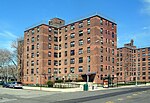Rockaway Freeway

The Rockaway Freeway is a road in the New York City borough of Queens that was created from the old right-of-way of the Long Island Rail Road Rockaway Division in 1941–1942 as part of the project to eliminate grade crossings within New York City. The railroad line itself was elevated over the new automotive route, and was incorporated into the New York City Subway system as the IND Rockaway Line (A train) in June 1956.Because of the large number of concrete posts supporting the elevated subway, the Freeway has consistently been hazardous for drivers; at least one driver died from crashing into a pillar. A portion of the road, between Beach 67th Street and Beach 73rd Street, was closed permanently in 2009 to make way for a retail transit plaza in connection with the new Arverne-by-the-Sea construction development.
Excerpt from the Wikipedia article Rockaway Freeway (License: CC BY-SA 3.0, Authors, Images).Rockaway Freeway
Rockaway Freeway, New York Queens
Geographical coordinates (GPS) Address External links Nearby Places Show on map
Geographical coordinates (GPS)
| Latitude | Longitude |
|---|---|
| N 40.591894444444 ° | E -73.792269444444 ° |
Address
Rockaway Freeway
Rockaway Freeway
12692 New York, Queens
New York, United States
Open on Google Maps










